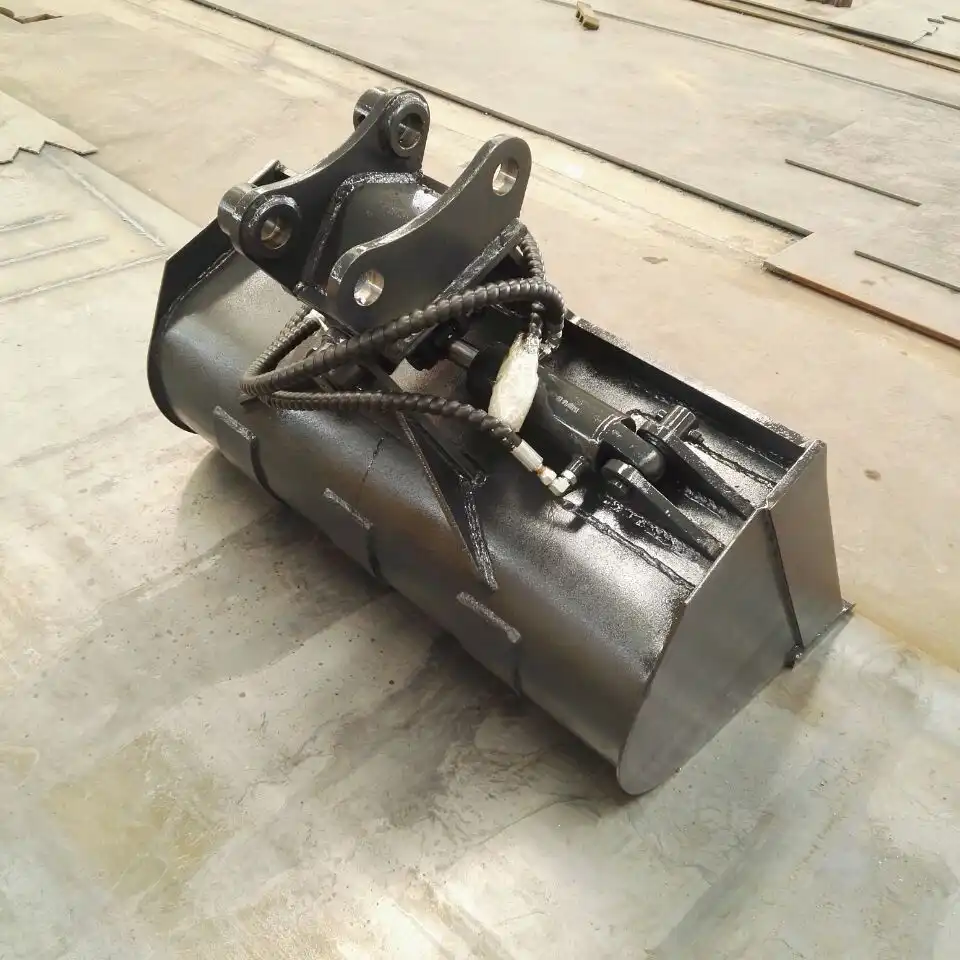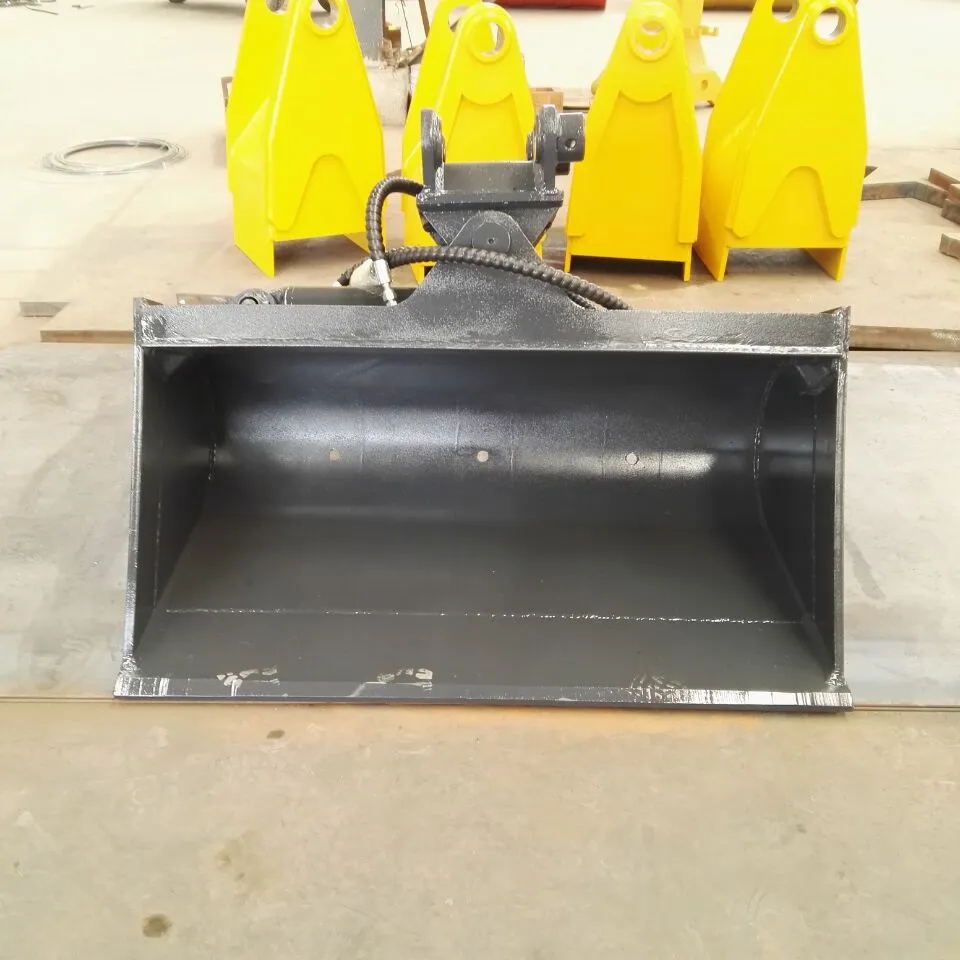Is Your Excavator Compatible with Tilt Buckets?
Determining whether your excavator is compatible with tilt buckets involves evaluating three critical factors: hydraulic system capabilities, physical size matching, and weight capacity considerations. Most excavators in the 7-15 ton range can accommodate a degree rotating hydraulic tilt ditching bucket with proper auxiliary hydraulic circuits and adequate lifting capacity. The compatibility largely depends on your machine's auxiliary hydraulic flow rate, mounting system configuration, and structural stability when handling tilting operations. Modern excavators equipped with dedicated auxiliary hydraulic lines typically support tilt bucket attachments without significant modifications. However, older machines or those without auxiliary circuits may require hydraulic system upgrades to operate tilt buckets effectively. The key compatibility indicators include having sufficient hydraulic flow (typically 15-25 GPM), appropriate mounting pin sizes, and adequate machine weight to counterbalance the attachment during operation.
Hydraulic System Requirements
Auxiliary Circuit Specifications
The foundation of tilt bucket compatibility lies in your excavator's auxiliary hydraulic system capabilities. A two-way auxiliary hydraulic circuit is required for operation, which means your machine must have dedicated auxiliary hydraulic lines beyond the standard boom, arm, and bucket circuits. Most modern excavators come equipped with these auxiliary circuits, but older models may require retrofitting to accommodate hydraulic tilt attachments.
Degree rotating tilt ditching bucket systems typically require hydraulic flow rates between 15-25 gallons per minute (GPM) to operate effectively. The hydraulic pressure requirements usually range from 2,500 to 3,500 PSI, depending on the bucket size and tilting mechanism design. Your excavator's hydraulic system must provide consistent pressure and flow to ensure smooth tilting operations without compromising the machine's primary functions.
The hydraulic control system integration varies among excavator manufacturers, but most systems utilize proportional control valves that allow operators to adjust tilting speed and precision. Some excavators feature dedicated control joysticks or buttons for auxiliary attachments, while others integrate tilt bucket controls into existing joystick patterns. Understanding your machine's control system layout helps determine installation complexity and operator training requirements.
Connection Types and Fittings
Hydraulic connection compatibility represents a crucial aspect often overlooked during initial compatibility assessments. Most tilt buckets utilize standard hydraulic quick-connect fittings, but fitting sizes and connection types can vary between manufacturers and regions. You will need hoses with 1/2" flat face couplings for many tilt bucket applications, though larger excavators may require different coupling sizes.
The routing of hydraulic lines from the excavator to the tilt bucket requires careful planning to prevent interference with machine operation. Lines must be routed away from moving parts, sharp edges, and areas prone to impact damage. Many tilt bucket installations include protective guards or routing systems that secure hydraulic lines while maintaining flexibility during operation.
Hydraulic system contamination poses significant risks to both the excavator and tilt bucket performance. Installing proper filtration and maintaining clean hydraulic fluid becomes even more critical when operating auxiliary attachments. Regular hydraulic system maintenance, including filter changes and fluid analysis, helps prevent costly repairs and ensures reliable tilt bucket operation.

Physical Size & Weight Compatibility
Mounting System Integration
The physical mounting interface between your excavator and tilt bucket determines compatibility and operational safety. Standard excavator mounting systems include pin-on connections, quick-attach couplers, and specialized mounting brackets designed for specific machine models. The mounting pin diameter, spacing, and load ratings must match between the excavator and tilt bucket to ensure safe operation.
Excavators in the 7-15 ton range typically feature mounting pin diameters between 50-80mm, depending on the manufacturer and model. The degree rotating hydraulic tilt ditching bucket mounting system must accommodate these specifications while providing adequate strength for tilting operations. Mismatched mounting systems can result in excessive wear, attachment failure, or safety hazards during operation.
The height clearance from the mounting pins to the bucket cutting edge affects digging depth and operational versatility. Tilt buckets typically add 6-12 inches to the overall attachment height compared to standard buckets, which may impact digging depth in confined spaces or when working under overhead obstacles. Understanding these dimensional changes helps operators plan work sequences and identify potential limitations.
Dimensional Specifications
The physical dimensions of tilt buckets must complement your excavator's size and operational requirements. Tilt Buckets are available for most machine sizes from 17 to 250 Class excavators, indicating broad compatibility across different excavator categories. However, selecting the appropriate bucket size ensures optimal performance and machine balance during operation.
Bucket width considerations impact both digging efficiency and transportation requirements. A 1600mm wide tilt bucket provides excellent productivity for grading and ditching operations but may require special transportation arrangements or present challenges in confined work areas. The 550mm height and 500mm depth specifications must align with your excavator's reach capabilities and intended applications.
Ground clearance becomes critical when operating tilt buckets on uneven terrain or in confined spaces. The additional height and complexity of tilt mechanisms can reduce ground clearance compared to standard buckets, potentially limiting access in certain working conditions. Evaluating typical work site conditions helps determine whether dimensional changes impact operational capabilities.
Weight Capacity & Stability
Load Rating Calculations
Understanding your excavator's load rating limitations becomes crucial when operating tilt bucket attachments that alter weight distribution and operational dynamics. The additional weight of tilt mechanisms, typically ranging from 200-800 pounds depending on bucket size, directly impacts your machine's lifting capacity and stability calculations. Manufacturers provide specific load charts that must be consulted when operating with auxiliary attachments.
Fits 6,000 to 10,000 lb. excavators represents typical weight class specifications for mid-range tilt buckets, indicating the importance of matching attachment specifications to excavator capabilities. Operating beyond recommended weight limits can result in tipping hazards, structural damage, or premature component wear that affects both safety and operational costs.
The dynamic loading conditions during tilting operations create additional stress on excavator components compared to standard bucket operations. The offset loading when the bucket tilts to extreme angles requires careful consideration of stability margins and may necessitate reduced operating speeds or modified work techniques to maintain safe working conditions.
Stability Margin Analysis
Excavator stability becomes more complex when operating tilt bucket attachments due to the changing center of gravity during tilting operations. The degree rotating hydraulic tilt ditching bucket capability to rotate 360 degrees and tilt 45 degrees creates operational positions that extend the attachment's center of gravity beyond normal working envelopes. This extension requires careful stability analysis and operator awareness.
The stability triangle concept applies differently when using tilt attachments, as the effective working radius changes during tilting operations. Operators must understand these stability implications and maintain adequate safety margins, particularly when working on slopes or uneven terrain. The additional weight and changed dynamics may require operating at reduced capacities in certain positions.
Ground conditions significantly impact stability when operating tilt buckets, as the additional weight and extended reach can increase ground pressure and reduce stability margins on soft or uneven surfaces. Understanding soil conditions and adjusting operating techniques accordingly helps maintain safe working conditions while maximizing productivity with tilt bucket attachments.
Counterweight Considerations
The counterweight capacity of your excavator determines its ability to safely operate tilt bucket attachments under various loading conditions. Machines designed for heavy attachments typically feature larger counterweights and reinforced undercarriage components that provide better stability margins when operating auxiliary attachments like tilt buckets.
Ballast considerations may become necessary when operating large tilt buckets on smaller excavators or when working in conditions that challenge stability margins. Some operators add temporary ballast to improve stability, though this approach must be carefully evaluated to avoid exceeding ground pressure limits or compromising machine mobility.
The relationship between excavator weight and tilt bucket capacity directly impacts operational efficiency and safety. 6,600-8,800 lbs Scandinavian Excavator Hydraulic Tilt Bucket specifications demonstrate how attachment sizing correlates with excavator weight classes. Proper matching ensures optimal performance while maintaining safety margins throughout the operating envelope.

FAQ
①What size excavator do I need for a tilt bucket?
Most degree rotating hydraulic tilt ditching bucket attachments are designed for excavators in the 7-15 ton range, though options exist for smaller and larger machines. The key factors include adequate hydraulic flow (15-25 GPM), auxiliary hydraulic circuits, and sufficient counterweight for stability during tilting operations.
②Can I retrofit my older excavator with auxiliary hydraulics?
Many older excavators can be retrofitted with auxiliary hydraulic systems to accommodate tilt buckets. The retrofit typically involves installing additional hydraulic pumps, control valves, and routing systems. Consult with a qualified hydraulic technician to evaluate feasibility and costs.
③How much does tilt bucket compatibility modification cost?
Compatibility modifications range from simple hydraulic fitting changes ($200-500) to complete auxiliary hydraulic system installations ($3,000-8,000). The cost depends on your excavator's existing capabilities and the complexity of required modifications.
④Will a tilt bucket affect my excavator's warranty?
Installing approved auxiliary attachments typically doesn't void excavator warranties, but modifications to hydraulic systems might. Always consult with your equipment dealer and review warranty terms before making modifications or installing tilt bucket attachments.
⑤What maintenance does a tilt bucket require?
Tilt buckets require regular inspection of hydraulic seals, pivot points, and mounting hardware. Daily visual inspections, weekly lubrication of pivot points, and periodic hydraulic system maintenance help ensure reliable operation and extend attachment life.
Evaluating excavator compatibility with tilt bucket attachments requires careful consideration of hydraulic capabilities, physical dimensions, and weight capacity factors. Understanding these compatibility requirements helps contractors make informed decisions about integrating advanced tilt bucket technology into their operations. The enhanced versatility and precision offered by tilt buckets can significantly improve operational efficiency when properly matched to compatible excavator platforms. For detailed compatibility assessments and expert guidance on selecting the right tilt bucket for your specific excavator model, contact the TianNuo Machinery technical team at tn@stnd-machinery.com.
References
- Thompson, R.L. and Johnson, M.K. (2023). "Excavator Hydraulic System Compatibility Analysis for Auxiliary Attachments." Journal of Construction Equipment Engineering, Vol. 45, No. 2, pp. 112-128.
- Anderson, P.J., Liu, S.H., and Brown, D.A. (2022). "Load Distribution and Stability Analysis of Excavator Tilt Bucket Attachments." Heavy Equipment Safety Review, Vol. 18, No. 4, pp. 203-219.
- Wilson, K.M. and Garcia, A.L. (2023). "Hydraulic Flow Requirements for Modern Excavator Attachments: Performance and Efficiency Studies." Hydraulic Systems Technology Quarterly, Vol. 29, No. 3, pp. 78-94.
- Chen, W.R., Martinez, J.P., and Davis, L.K. (2022). "Excavator Attachment Compatibility: Engineering Guidelines for Safe Operation." Construction Equipment Management Journal, Vol. 34, No. 6, pp. 145-162.
- Roberts, T.S., Kumar, V.N., and Miller, E.J. (2023). "Weight Distribution and Counterbalance Analysis for Hydraulic Excavator Attachments." Equipment Engineering and Design Review, Vol. 21, No. 1, pp. 34-51.
About Author: Arm
Arm is a leading expert in the field of specialized construction and railway maintenance equipment, working at Tiannuo Company.

